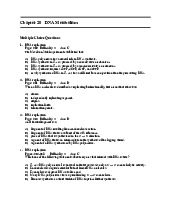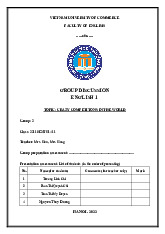







Preview text:
The Psychology Of Innovation IELTSReading Answers with Explanation
Luyện tập đê IELTS Reading Practice với passage The Psychology Of Innovation
được lấy từ cuốn sach IELTS Cambridge IELTS Practice Test 10 - Test 1 - Passage 3
với trải nghiệm thi IELTS trên may và giải thích đap an chi tiết bằng Linearthinking,
kèm list từ vựng IELTS cần học trong bài đọc.
DOL IELTS Đình Lực 28/02/2022 Làm Bài Xem giải thích t Từ vựng Bài đọc (reading passage )
The psychology of innovation
Why are so few companies truly innovative?
Innovation is key to business survivaland companies put substantial resources into inspiring employees to
develop new ideas. There are, nevertheless, people working in luxurious, state-of-the-art centres
designed to stimulate innovation who find that their environment doesn’t make them feel at al creative.
And there are those who don’t have a budget, or much space, but who innovate successful y.
For Robert B. Cialdini, Professor of Psychology at Arizona State University, one reason that companies
don’t succeed as often as they should is that innovation starts with recruitment. Research shows that the
fit between an employee’s values and a company’s values makes a difference to what contribution they
make and whether, two years after they join, they’re stil at the company. Studies at Harvard Business
School show that, although some individuals may be more creative than others, almost every individual
can be creative in the right circumstances.
One of the most famous photographs in the story of rock’n’rol emphasises Ciaidini’s views. The 1956
picture of singers Elvis Presley, Carl Perkins, Johnny Cash and Jerry Lee Lewis jamming at a piano in Sun
Studios in Memphis tel s a hidden story. Sun’s ‘mil ion-dol ar quartet’ could have been a quintet. Missing
from the picture is Roy Orbison’ a greater natural singer than Lewis, Perkins or Cash. Sam Phil ips, who
owned Sun, wanted to revolutionise popular music with songs that fused black and white music, and
country and blues. Presley, Cash, Perkins and Lewis instinctively understood Phil ips’s ambition and
believed in it. Orbison wasn’t inspired by the goal, and only ever achieved one hit with the Sun label.
The value fit matters, says Cialdini, because innovation is, in part, a process of change, and under that
pressure we, as a species, behave differently, ‘When things change, we are hard-wired to play it safe.’
Managers should therefore adopt an approach that appears counterintuitive -they should explain what
stands to be lost if the company fails to seize a particular opportunity. Studies show that we invariably
take more gambles when threatened with a loss than when offered a reward.
Managing innovation is a delicate art. It’s easy for a company to be pul ed in conflicting directions as the
marketing, product development, and finance departments each get different feedback from different sets
of people. And without a system which ensures col aborative exchanges within the company, it’s also easy
for smal ‘pockets of innovation to disappear. Innovation is a contact sport. You cant brief people just by
saying, ‘We’re going in this direction and I’m going to take you with me.’
Cialdini believes that this ‘fol ow-the-leader syndrome, is dangerous, not least because it encourages
bosses to go it alone. ‘It’s been scientifical y proven that three people wil be better than one at solving
problems, even if that one person is the smartest person in the field.’ To prove his point, Cialdini cites an
interview with molecular biologist James Watson. Watson, together with Francis Crick, discovered the
structure of DNA, the genetic information carrier of al living organisms. ‘When asked how they had
cracked the code ahead of an array of highly accomplished rival investigators, he said something that
stunned me. He said ”he and Crick had succeeded because they were aware that they weren’t the most
intel igent of the scientists pursuing the answer. The smartest scientist was cal ed Rosalind Franklin who,
Watson said, “was so intel igent she rarely sought advice”.’
Teamwork taps into one of the basic drivers of human behaviour. ‘The principle of social proof is so
pervasive that we don’t even recognise it,’ says Cialdini. ‘If your project is being resisted, for example, by a
group of veteran employees, ask another old-timer to speak up for it.’ Cialdini is not alone in advocating
this strategy. Research shows that peer power, used horizontal y not vertical y, is much more powerful than any boss’s speech.
Writing, visualising and prototyping can stimulate the flow of new ideas. Cialdini cites scores of research
papers and historical events that prove that even something as simple as writing deepens every
individual’s engagement in the project. It is, he says, the reason why al those competitions on breakfast
cereal packets encouraged us to write in saying, in no more than 10 words: ‘I like Kel ogg’s Com Flakes
because. . . ’ The very act of writing makes us more likely to believe it.
Authority doesn’t have to inhibit innovation but it often does. The wrong kind of leadership wil lead to
what Cialdini cal s ”captainitis, the regrettable tendency of team members to opt out of team
responsibilities that are properly their’. He cal s it captainitis because, he says, ”crew members of
multipilot aircraft exhibit a sometimes deadly passivity when the flight captain makes a clearly wrong-
headed decision”. This behaviour is not, he says, unique to air travel, but can happen in any workplace
where the leader is overbearing.
At the other end of the scale is the 1980s Memphis design col ective, a group of young designers for
whom ”the only rule was that there were no rule”. This environment encouraged a free interchange of
ideas, which led to more creativity with form, function, colour and materials that revolutionised attitudes to furniture design.
Many theorists believe the ideal boss should lead from behind, taking pride in col ective accomplishment
and giving credit where it is due. Cialdini says:”Leaders should encourage everyone to contribute and
simultaneously assure al concerned that every recommendation is important to making the right decision
and wil be given ful attention” The frustrating thing about innovation is that there are many approaches,
but no magic formula. However, a manager who wants to create a truly innovative culture can make their
job a lot easier by recognising these psychological realities. Câu hỏi (questions ) Question 1 - 4
Choose appropriate options A, B, C or D. 1
The example of the ‘mil ion-dol ar quartet’ underlines the writer’s point about A recognising talent B working as a team. C having a shared objective. D being an effective leader. 2
James Watson suggests that he and Francis Crick won the race to discover the DNA code because they A
were conscious of their own limitations B
brought complementary skil s to their partnership. C
were determined to outperform their brighter rivals D
encouraged each other to realise their joint ambition 3
The writer mentions competitions on breakfast cereal packets as an example of how to A inspire creative thinking B generate concise writing C promote loyalty to a group D
strengthen commitment to an idea 4
In the last paragraph, the writer suggests that it is important for employees to A
be aware of their company's goals B
feel that their contributions are valued C
have respect for their co-workers achievements D
understand why certain management decisions are made Question 5 - 9
Complete each sentence with the correct ending, A-G, below. Write the correct letter, A-G List of Endings A take chances. B share their ideas. C become competitive. D get promotion E avoid risk F ignore their duties G remain in their jobs
Employees whose values match those of their employers are more likely to 5
At times of change, people tend to 6
If people are aware of what they might lose, they wil often 7
People working under a dominant boss are liable to 8
Employees working in organisations with few rules are more likely to 9 Question 10 - 14
Do the fol owing statements agree with the information given in the Reading Passage?
In fol owing statements below, choose YES
if the statement agrees with the information NO
if the statement contradicts the information NOT GIVEN
if it is impossible to say what the writer thinks about this 10
The physical surroundings in which a person works play a key role in determining their creativity 11
Most people have the potential to be creative 12
Teams work best when their members are of equal y matched intel igence 13
It is easier for smal er companies to be innovative. 14
A manager’s approval of an idea is more persuasive than that of a col eague.
Answer key (đap an và giải thích) 1 C Xem ful giải thích lengl 2 A Xem ful giải thích lengl 3 D Xem ful giải thích lengl 4 B Xem ful giải thích lengl 5 G Xem ful giải thích lengl 6 E Xem ful giải thích lengl 7 A Xem ful giải thích lengl 8 F Xem ful giải thích lengl 9 B Xem ful giải thích lengl 10 No Xem ful giải thích lengl 11 Yes Xem ful giải thích lengl 12 Not Given Xem ful giải thích lengl 13 Not Given Xem ful giải thích lengl 14 No Xem ful giải thích lengl
Hãy cùng DOL kham pha kho đê thi IELTS Reading Practice với lời giải thích chi tiết ở đây ->
Document Outline
- Luyện tập đề IELTS Reading Practice với passage T
- Bài đọc (reading passage )
- Câu hỏi (questions )
- Question 1 - 4
- Question 5 - 9
- Question 10 - 14




